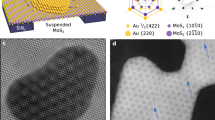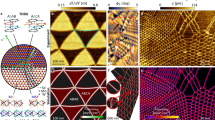Abstract
Moiré superlattices in van der Waals heterostructures have given rise to a number of emergent electronic phenomena due to the interplay between atomic structure and electron correlations. Indeed, electrons in these structures have been recently found to exhibit a number of emergent properties that the individual layers themselves do not exhibit. This includes superconductivity1,2, magnetism3, topological edge states4,5, exciton trapping6 and correlated insulator phases7. However, the lack of a straightforward technique to characterize the local structure of moiré superlattices has thus far impeded progress in the field. In this work we describe a simple, room-temperature, ambient method to visualize real-space moiré superlattices with sub-5-nm spatial resolution in a variety of twisted van der Waals heterostructures including, but not limited to, conducting graphene, insulating boron nitride and semiconducting transition metal dichalcogenides. Our method uses piezoresponse force microscopy, an atomic force microscope modality that locally measures electromechanical surface deformation. We find that all moiré superlattices, regardless of whether the constituent layers have inversion symmetry, exhibit a mechanical response to out-of-plane electric fields. This response is closely tied to flexoelectricity wherein electric polarization and electromechanical response is induced through strain gradients present within moiré superlattices. Therefore, moiré superlattices of two-dimensional materials manifest themselves as an interlinked network of polarized domain walls in a non-polar background matrix.
This is a preview of subscription content, access via your institution
Access options
Access Nature and 54 other Nature Portfolio journals
Get Nature+, our best-value online-access subscription
$29.99 / 30 days
cancel any time
Subscribe to this journal
Receive 12 print issues and online access
$259.00 per year
only $21.58 per issue
Buy this article
- Purchase on Springer Link
- Instant access to full article PDF
Prices may be subject to local taxes which are calculated during checkout




Similar content being viewed by others
Data availability
Data is available from the corresponding author upon request.
References
Cao, Y. et al. Unconventional superconductivity in magic-angle graphene superlattices. Nature 556, 43–50 (2018).
Yankowitz, M. et al. Tuning superconductivity in twisted bilayer graphene. Science 363, 1059–1064 (2019).
Sharpe, A. L. et al. Emergent ferromagnetism near three-quarters filling in twisted bilayer graphene. Science 365, 605–608 (2019).
Huang, S. et al. Topologically protected helical states in minimally twisted bilayer graphene. Phys. Rev. Lett. 121, 037702 (2018).
Sunku, S. S. et al. Photonic crystals for nano-light in moiré graphene superlattices. Science 362, 1153–1156 (2018).
Seyler, K. L. et al. Signatures of moiré-trapped valley excitons in MoSe2/WSe2 heterobilayers. Nature 567, 66–70 (2019).
Cao, Y. et al. Correlated insulator behaviour at half-filling in magic-angle graphene superlattices. Nature 556, 80–84 (2018).
Yoo, H. et al. Atomic and electronic reconstruction at the van der Waals interface in twisted bilayer graphene. Nat. Mater. 18, 448–453 (2019).
Alden, J. S. et al. Strain solitons and topological defects in bilayer graphene. Proc. Natl Acad. Sci. USA 110, 11256–11260 (2013).
Zhang, C. et al. Interlayer couplings, moiré patterns, and 2D electronic superlattices in MoS2/WSe2 hetero-bilayers. Sci. Adv. 3, e1601459 (2017).
Kerelsky, A. et al. Maximized electron interactions at the magic angle in twisted bilayer graphene. Nature 572, 95–100 (2019).
Gargiulo, F. & Yazyev, O. V. Structural and electronic transformation in low-angle twisted bilayer graphene. 2D Mater. 5, 015019 (2017).
Chandratre, S. & Sharma, P. Coaxing graphene to be piezoelectric. Appl. Phys. Lett. 100, 023114 (2012).
Ong, M. T. & Reed, E. J. Engineered piezoelectricity in graphene. ACS Nano 6, 1387–1394 (2012).
da Cunha Rodrigues, G. et al. Strong piezoelectricity in single-layer graphene deposited on SiO2 grating substrates. Nat. Commun. 6, 7572 (2015).
Wang, X. et al. Observation of a giant two-dimensional band-piezoelectric effect on biaxial-strained graphene. NPG Asia Mater. 7, e154–e154 (2015).
Van der Donck, M., De Beule, C., Partoens, B., Peeters, F. M. & Van Duppen, B. Piezoelectricity in asymmetrically strained bilayer graphene. 2D Mater. 3, 035015 (2016).
Balke, N. et al. Differentiating ferroelectric and nonferroelectric electromechanical effects with scanning probe microscopy. ACS Nano 9, 6484–6492 (2015).
Kalinin, S. V., Jesse, S., Tselev, A., Baddorf, A. P. & Balke, N. The role of electrochemical phenomena in scanning probe microscopy of ferroelectric thin films. ACS Nano 5, 5683–5691 (2011).
Labuda, A. & Proksch, R. Quantitative measurements of electromechanical response with a combined optical beam and interferometric atomic force microscope. Appl. Phys. Lett. 106, 1–5 (2015).
Kalinin, S. V. et al. Vector piezoresponse force microscopy. Microsc. Microanal. 12, 206–220 (2006).
Wang, B., Gu, Y., Zhang, S. & Chen, L.-Q. Flexoelectricity in solids: progress, challenges, and perspectives. Prog. Mater. Sci. 106, 100570 (2019).
Dumitrică, T., Landis, C. M. & Yakobson, B. I. Curvature-induced polarization in carbon nanoshells. Chem. Phys. Lett. 360, 182–188 (2002).
Kalinin, S. V. & Meunier, V. Electronic flexoelectricity in low-dimensional systems. Phys. Rev. B 77, 033403 (2008).
Kothari, M., Cha, M. & Kim, K. Critical curvature localization in graphene. I. Quantum-flexoelectricity effect. Proc. R. Soc. A 474, 20180054 (2018).
Kundalwal, S. I., Meguid, S. A. & Weng, G. J. Strain gradient polarization in graphene. Carbon 117, 462–472 (2017).
Dreyer, C. E., Stengel, M. & Vanderbilt, D. Current-density implementation for calculating flexoelectric coefficients. Phys. Rev. B 98, 075153 (2018).
Stengel, M. Surface control of flexoelectricity. Phys. Rev. B 90, 201112 (2014).
Perdew, J. P., Burke, K. & Ernzerhof, M. Generalized gradient approximation made simple. Phys. Rev. Lett. 77, 3865 (1996).
Blöchl, P. E. Projector augmented-wave method. Phys. Rev. B 50, 17953 (1994).
Kresse, G. & Furthmüller, J. Efficient iterative schemes for ab initio total-energy calculations using a plane-wave basis set. Phys. Rev. B 54, 11169 (1996).
Monkhorst, H. J. & Pack, J. D. Special points for brillouin-zone integrations. Phys. Rev. B 13, 5188 (1976).
Popov, A. M., Lebedeva, I. V., Knizhnik, A. A., Lozovik, Y. E. & Potapkin, B. V. Commensurate-incommensurate phase transition in bilayer graphene. Phys. Rev. B. 84, 045404 (2011).
Acknowledgements
This work is supported by the Programmable Quantum Materials (Pro-QM) programme at Columbia University, an Energy Frontier Research Center established by the Department of Energy (grant no. DE-SC0019443). L.J.M. acknowledges support from the Swiss National Science Foundation (grant no. P400P2_186744). Synthesis of MoSe2 and WSe2 was supported by the National Science Foundation Materials Research Science and Engineering Centers programme through Columbia in the Center for Precision Assembly of Superstratic and Superatomic Solids (DMR-1420634). The Flatiron Institute is a division of the Simons Foundation. C.E.D. acknowledges support from the National Science Foundation under grant no. DMR-1918455. M.S. and K.S. acknowledge the support of the European Research Council under the European Union’s Horizon 2020 research and innovation programme (grant agreement no. 724529), Ministerio de Economia, Industria y Competitividad through grant nos. MAT2016-77100-C2-2-P and SEV-2015-0496, and the Generalitat de Catalunya (grant no. 2017SGR 1506). We thank D. Griffin and T. Walsh from Oxford Instruments Asylum Research for confirmation of PFM results.
Author information
Authors and Affiliations
Contributions
L.J.M. conceived the concept of the study and initiated the first PFM experiments. A.K., N.R.F., E.-M.S., A.G., Y.Z., S.L.M., W.W., Y.B. and L.Z. provided additional samples and experimental results. K.S., M.S. and C.E.D performed theoretical calculations and simulations. K.W. and T.T. provided hBN crystals. J.H., X.Z., D.N.B., C.D., C.E.D. and A.N.P. advised. L.J.M and A.N.P. wrote the manuscript with assistance from all authors.
Corresponding author
Ethics declarations
Competing interests
The authors declare no competing interests.
Additional information
Publisher’s note Springer Nature remains neutral with regard to jurisdictional claims in published maps and institutional affiliations.
Extended data
Extended Data Fig. 1 Example of large-scale mapping of moiré superlattice.
A lateral PFM image for a scan of 8 × 8 µm2; topography (a), phase (b) and amplitude (c) demonstrating that this technique can be used to observe the moiré across length scales that span orders of magnitude. Note the huge variation in moiré wavelength from ~500 to ~50 nm and presence of large strains.
Extended Data Fig. 2 Example of mapping of two co-existing moiré superlattices.
Amplitude (a) and phase (b) images clearly show a strained moiré superlattice due to the twisted bilayer of graphene with wavelength \(\lambda _m^{tBLG}\sim 70\,{\mathrm{nm}}\) and a second smaller wavelength related to the bottom layer of graphene with the hBN flake of \(\lambda _m^{SLG}\sim 4.5\,{\mathrm{nm}}\).
Supplementary information
Supplementary Information
Supplementary sections 1–7, Figs. 1–7 and refs. 1 and 2.
Rights and permissions
About this article
Cite this article
McGilly, L.J., Kerelsky, A., Finney, N.R. et al. Visualization of moiré superlattices. Nat. Nanotechnol. 15, 580–584 (2020). https://doi.org/10.1038/s41565-020-0708-3
Received:
Accepted:
Published:
Issue Date:
DOI: https://doi.org/10.1038/s41565-020-0708-3
This article is cited by
-
Engineering interlayer hybridization in van der Waals bilayers
Nature Reviews Materials (2024)
-
Non-volatile electrical polarization switching via domain wall release in 3R-MoS2 bilayer
Nature Communications (2024)
-
Twistronics and moiré excitonic physics in van der Waals heterostructures
Frontiers of Physics (2024)
-
Moiré straintronics: a universal platform for reconfigurable quantum materials
npj 2D Materials and Applications (2023)
-
Every-other-layer dipolar excitons in a spin-valley locked superlattice
Nature Nanotechnology (2023)



